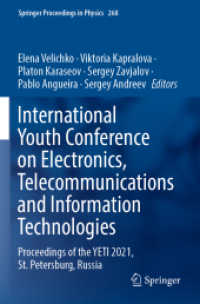- ホーム
- > 洋書
- > ドイツ書
- > Mathematics, Sciences & Technology
- > Chemistry
- > physical chemistry
Full Description
Increase photocatalytic efficiency with cutting-edge materials
Photocatalysis, which modifies the rate of reactions stimulated by light absorption, can be a critical component of many catalytic processes. Layered structures can be used in photocatalysis to broaden surface area and generate more numerous reaction sites, which can in turn increase both photocatalytic activity and quantum efficiency. In recent years these layered materials have generated numerous applications in energy production and environmental chemistry.
Layered Materials in Photocatalysis introduces these materials, their historical development, and their key properties. Analyzing all major classifications of layered photocatalysts, it details their key environmental and energy applications and offers predictions for future research and development. The result is a crucial volume summarizing a growing technology.
Layered Materials in Photocatalysis readers will also find:
Combines both science and skills for professionals in the field
Detailed discussion of layered bismuth-based photocatalysts, metal-free layered photocatalysts, and many more
Authored by one of the leading experts in structured materials in photocatalysis
Layered Materials in Photocatalysis is ideal for catalytic chemists, photochemists, and any other scientists working with catalytic or energy-generating processes.
Contents
Preface xiii
1 Basic Principles of Photocatalysis 1
Baker Rhimi and Zhifeng Jiang
1.1 Introduction 1
1.2 Definition and Fundamental Principles of Photocatalysis 2
1.3 Factors Affecting Photocatalytic Performance 6
1.3.1 Light Absorption 6
1.3.1.1 Metal/Nonmetal Doping 7
1.3.1.2 Plasmonic Photocatalysts 8
1.3.2 Charge Carrier Separation and Transfer 10
1.3.2.1 Solid-Solid Junctions 10
1.3.2.2 Facet Engineering 12
1.3.2.3 Cocatalyst Loading 13
1.4 Investigation of Photocatalysis for Real Applications 14
1.5 Conclusion 16
References 17
2 The Role of Layer Structure in Photocatalysis 21
Kaiting Yang and Xiaoli Jin
2.1 Layered Structure 21
2.1.1 Layer Structured Catalysts 21
2.2 Application Fields of Layered Catalysts 23
2.2.1 Photocatalytic Water Decomposition to Produce Hydrogen 23
2.2.2 Photocatalytic Reduction of CO2 23
2.2.3 Photocatalytic Production of H2 O2 23
2.2.4 Photocatalytic Nitrogen Fixation 24
2.2.5 Photocatalytic Degradation of Pollutants 24
2.3 Function of Layered Structure 24
2.3.1 Forming a Strong Built-in Electric Field 25
2.3.2 Increasing Active Sites 27
2.4 Preparation of Layered Catalyst 28
2.4.1 Hydrothermal/Solvothermal Method 28
2.4.2 Solid-phase Synthesis Method 29
2.4.3 Template Method 29
2.4.4 Sol-Gel Method 29
2.5 Research Direction of Layered Catalysts 30
2.5.1 Ultrathin Thickness 30
2.5.2 Active Crystal Surface 30
2.5.3 Morphology Control 31
2.5.4 Semiconductor Composite 31
References 32
3 Applications of Layered Photocatalysts 35
Rumeng Zhang and Dehua Xia
3.1 Introduction 35
3.2 Hydrogen Generation 36
3.3 CO2 Reduction 39
3.4 N2 Fixation 44
3.5 Removal of Pollutions 47
3.6 Organic Synthesis 50
3.7 H2 O2 Production 51
3.8 Conclusion 53
References 54
4 Layered Bismuth-Based Photocatalysts 1: BiOX (X = Cl, Br, I) 59
Yi Zhang and Jun di
4.1 Introduction 59
4.2 Crystal Structure of BiOX 59
4.3 Synthesis Methods for BiOX 61
4.3.1 Hydrothermal and Solvent-Thermal Methods 63
4.3.2 High-Temperature Solid-Phase Synthesis Method 64
4.3.3 Chemical Deposition Method 65
4.3.4 Mechanochemical Method 67
4.3.5 Microwave Method 67
4.3.6 Reactive Ionic Liquid Method 68
4.4 Modification Strategies for Bismuth Oxyhalide Photocatalysts 69
4.4.1 Composition Modulation 69
4.4.1.1 Bismuth-Rich Strategy 70
4.4.1.2 Defect Engineering 73
4.4.1.3 Elemental Doping 74
4.4.1.4 Solid Solution Strategy 76
4.4.2 Structural Regulation Strategy 78
4.4.2.1 Morphostructural Modulation 78
4.4.2.2 Facet-Synergistic Mechanisms 87
4.4.3 Heterojunction Structure Construction 90
4.4.3.1 2D-2D Faceted Junctions 90
4.4.3.2 Type I Heterojunctions 91
4.4.3.3 Type II Heterojunctions 92
4.4.3.4 p-n Type Heterojunctions 92
4.4.3.5 Z-Scheme Heterojunctions 93
4.4.3.6 S-Scheme Heterojunctions 94
4.4.3.7 Facet Heterojunctions 95
4.4.4 Single-Atom Engineering 96
4.4.5 Polarization Strategy 97
4.4.6 Surface Plasmon Excitation Effect 101
4.5 Photocatalytic Applications of BiOX 102
4.5.1 Applications in the Field of Environmental Remediation 103
4.5.1.1 Water Pollution Purification 103
4.5.1.2 Air Pollution Control 103
4.5.1.3 Heavy Metal Removal 104
4.5.2 Applications in the Field of Energy Conversion 104
4.5.2.1 Hydrogen Production 104
4.5.2.2 CO2 Reduction 104
4.5.2.3 N2 Fixation 105
4.5.3 Others 108
4.5.3.1 Photodynamic Therapy 108
4.5.3.2 Organic Synthesis 109
4.6 Conclusions and Perspectives 110
References 111
5 Layered Bismuth-Based Photocatalysts 2 BiXO4 (x = V, P) 117
Shi Xian
5.1 BiVO4 Photocatalyst 117
5.1.1 Crystal Structures of BiVO4 117
5.1.2 Electronic Structures of BiVO4 119
5.1.3 Optical Characteristics of BiVO4 120
5.1.4 Preparation of BiVO4 122
5.1.4.1 High-Temperature Solid-State Reaction Method 122
5.1.4.2 Coprecipitation Method 123
5.1.4.3 Hydrothermal Method 123
5.1.4.4 Microwave-Assisted Method 123
5.1.4.5 Sol-Gel Method 123
5.1.5 Modification of BiVO4 124
5.1.5.1 Ion Doping 124
5.1.5.2 Morphology Control 124
5.1.5.3 Crystallographic Engineering 125
5.1.5.4 BiVO4 -Based Heterojunction Composite Materials 125
5.2 BiPO4 Photocatalyst 126
5.2.1 Crystal Structures of BiPO4 126
5.2.2 Preparation of BiPO4 126
5.2.2.1 Hydrothermal Method 126
5.2.2.2 Solvothermal Method 126
5.2.2.3 Microwave-Assisted Method 127
5.2.2.4 Ultrasonic Method 127
5.2.3 Application of BiPO4 in the Field of Photocatalysis 127
5.2.4 Strategies for Improving the Photocatalytic Performances of BiPO4 127
5.2.4.1 Optimizing Preparation Methods 128
5.2.4.2 Doping Modification 128
5.2.4.3 Heterogeneous Structure Construction 129
References 130
6 Layered Bismuth-Based Photocatalysts 3: Bi2 XO6 (X = Mo, W) 133
Gongzhe Nie
6.1 Introduction 133
6.2 The Preparation Method and Structural Characteristics of Bi2 XO6 (X = Mo, W) 134
6.2.1 Solvothermal Synthesis 135
6.2.1.1 Synthesis Reaction General Steps 135
6.2.1.2 Control of Particle Size and Morphology 136
6.2.1.3 Additives and Surfactants 136
6.3 Performance of Bi2 XO6 (X = Mo, W) Photocatalyst Coupled with Other Substances in the Treatment of Environmental Pollution 140
6.4 The Mechanism of Bi2 XO6 (X = Mo, W) Photocatalyst in Dealing with the Problem of Environmental Pollution 143
6.5 Conclusion 145
References 145
7 Metal-Free Layered Photocatalyst: g-C3 N4 153
Jia Wu and Wei Liu
7.1 Introduction of g-C3 N4 154
7.2 Preparation Method of g-C3 N4 155
7.3 Methods for the Modification of g-C3 N4 157
7.3.1 The Morphological Control of g-C3 N4 158
7.3.1.1 Hard-Template-Method-Modified g-C3 N4 158
7.3.1.2 Soft-Template-Method-Modified g-C3 N4 159
7.3.1.3 Template-Free Method 160
7.3.2 Elemental Doping of g-C3 N4 160
7.3.2.1 Nonmetallic Element Doping 160
7.3.2.2 Metallic Element Doping 161
7.3.3 Exfoliation Method 162
7.3.3.1 Thermal Oxidation Exfoliation 162
7.3.3.2 Ultrasound Exfoliation 163
7.3.3.3 Chemical Exfoliation 164
7.3.4 Defect Engineering 164
7.3.5 Construction of Heterojunction 165
7.3.5.1 Compound/g-C3 N4 Heterojunction 166
7.3.5.2 Metal Sulfide/g-C3 N4 Heterojunction 167
7.3.5.3 MOF/g-C3 N4 Heterojunction 167
7.3.5.4 Metal Oxide/g-C3 N4 Heterojunction 168
7.3.5.5 The Z-Scheme Heterojunction 168
7.3.6 Surface-Loading Cocatalyst 170
7.4 Carbon Nitride Applications in Photocatalysis 170
7.4.1 Carbon Nitride Applications in Photocatalysis 170
7.4.1.1 Degrading Pollutants 170
7.4.1.2 Photohydrolysis of Water to Produce Hydrogen 171
7.4.1.3 Photocatalytic Reduction of CO2 171
7.4.1.4 Inactivation of Bacteria 172
7.5 Summary and Outlook 173
References 173
8 Metal-Free Layered Photocatalysts 2: Covalent Organic Framework 181
Rumeng Zhang and Dehua Xia
8.1 Introduction 181
8.2 Preparation Method of COFs 182
8.3 H2 Production 184
8.4 CO2 Reduction 187
8.5 Removal of Pollution 189
8.6 Photocatalytic Organic Conversion 190
8.7 H2 O2 Production 192
8.8 Conclusion 194
References 195
9 Layered Double Hydroxide Photocatalysts 197
Xing Li, Wanfen Pu, Pingya Luo, and Yang Bai
9.1 About LDHs 197
9.1.1 The History 197
9.1.2 Crystal Structures and Properties 197
9.1.2.1 Structures 197
9.1.2.2 Properties 199
9.2 Preparation and Photocatalytic Functionalization of LDHs 200
9.2.1 Preparation of Infrastructure LDHs 200
9.2.1.1 Coprecipitation 200
9.2.1.2 Hydrothermal/Solvothermal 201
9.2.1.3 Anion Exchange 201
9.2.1.4 Roasting Reduction 201
9.2.1.5 Sol-Gel 201
9.2.1.6 Self-Assembly 202
9.2.2 Functionalization Strategies for Ohotocatalysis 202
9.2.2.1 Guest Modification 202
9.2.2.2 Host Modification 203
9.2.2.3 2D Exfoliation Strategies 204
9.2.2.4 Hybridization 204
9.2.2.5 Morphology Adjustment 204
9.2.2.6 Defect Engineering 205
9.2.2.7 Surface Modification 205
9.3 Application in Environments 205
9.3.1 Characteristics 205
9.3.2 Application Examples 206
9.3.2.1 Water Purification 206
9.3.2.2 Air Purification 209
9.4 Application in Energy 209
9.4.1 Characteristics 209
9.4.2 CO2 Reduction Reaction (CO2 RR) 211
9.4.3 Water Splitting 213
9.5 Outlook 217
References 217
10 Layer-Structured Cocatalyst for Photocatalysis: Graphene 221
Mengmeng Liu and Wei Liu
10.1 Introduction to Graphene 221
10.2 Correlation Property 221
10.3 Preparation Method 222
10.3.1 Preparation of Graphene 222
10.3.1.1 Micromechanical Exfoliation Method 223
10.3.1.2 Liquid Phase Stripping Method 223
10.3.1.3 Chemical Vapor Deposition (CVD) 224
10.3.1.4 Hummers Method (Graphene Oxide) 224
10.3.2 Preparation of Graphene-Based Semiconductor Photocatalysts 227
10.3.2.1 In Situ Growth Strategy 227
10.3.2.2 Solution Mixing Method 227
10.3.2.3 Hydrothermal/Solvothermal Method 229
10.3.2.4 Other Methods 231
10.4 Graphene-Based Photocatalyst Heterojunction 231
10.4.1 Schottky Junctions 232
10.4.2 Type II Heterojunctions 232
10.4.2.1 N-N Heterojunction 233
10.4.2.2 P-N Heterojunction 233
10.4.3 Z-Type Heterojunctions 234
10.4.3.1 Indirect Z-Scheme Heterojunctions 234
10.4.3.2 Direct Z-Scheme Heterojunctions 235
10.4.4 Van der Waals Heterostructures 236
10.5 Application of Photocatalysis 238
10.5.1 CO2 Reduction 238
10.5.2 Hydrogen Generation 239
10.5.3 Pollutant Degradation 239
10.5.4 Photocatalytic Disinfection 240
10.6 Conclusion and Prospect 241
References 241
11 Layer Structured Cocatalyst for Photocatalysis: Transition Metal Sulfide 245
Zhaoyu Ma and Wenping li
11.1 Introduction 245
11.2 Fundamentals of Two-Dimensional Transition Metal Sulfide 246
11.2.1 Composition 246
11.2.2 Photocatalytic Mechanism of TMDs 247
11.3 Synthesis Methods 249
11.4 Design of TMDs Cocatalysts 252
11.5 Applications in Photocatalysis 253
11.5.1 Photocatalytic Water Splitting 253
11.5.2 Photocatalytic CO2 Conversion 255
11.5.3 Photocatalytic Degradation of Pollutants 257
11.6 Future Outlook 258
References 259
12 Layer Structured Cocatalyst 3 for Photocatalysis: MXene 263
Qizhao Wang
12.1 Structure of MXene 263
12.2 Preparation of MXene 265
12.2.1 Hydrofluoric Acid Etching Method (HF) 266
12.2.2 Fluorinated Salt Etching 268
12.2.3 Chemical Vapor Deposition Method 269
12.2.4 Other Etching Methods 269
12.3 Physicochemical Properties of MXene 271
12.3.1 Stability 271
12.3.2 Surface Chemical Properties 272
12.3.3 Electrical Properties 272
12.3.4 Optical Properties 273
12.3.5 Mechanical Properties 273
12.3.6 Other Properties 274
12.4 Mechanism of MXene as Cocatalyst in Photocatalysis 274
12.5 MXenes in Enhancing Photocatalyst Activity 275
12.5.1 Electronic Storage 275
12.5.2 Adsorbents 276
12.5.3 Hole Receiver 276
12.5.4 Active Site 276
12.6 Application of MXene in Photocatalysis 278
12.6.1 Hydrogen Production from Water Decomposition 278
12.6.2 CO2 Reduction 279
12.6.2.1 Nitride/MXene 280
12.6.2.2 Metal Oxide/MXene 282
12.6.2.3 Metal Salt/MXene 285
12.6.2.4 Perovskite/MXene 286
12.6.2.5 LDH/MXene 287
12.6.2.6 Functionalized MXenes 288
12.6.3 MXene in Photocatalytic Nitrogen Fixation 289
12.6.4 Photocatalytic Degradation of Organic Pollutants 290
12.7 Perspectives of MXene in the Field of Photocatalysis 293
References 294
13 Face-to-Face 2D/2D Heterojunction Between Layered Photocatalysts 299
Wei-Kean Chong, Xin Ying Kong, Siang-Piao Chai, and Teck Peng Loh
13.1 Introduction 299
13.2 Principles and Characteristics of Face-to-Face 2D/2D Heterojunction 300
13.3 Synthesis Strategies for 2D/2D Face-to-Face Heterojunction 303
13.3.1 In Situ Hydrothermal and Solvothermal Approaches 303
13.3.2 Ex Situ Electrostatic Self-Assembly 305
13.4 Photocatalytic Applications of 2D/2D Heterostructures 307
13.4.1 CO2 Reduction into Carbon-Neutral Fuels 307
13.4.2 Water Splitting for H2 and O2 Production 311
13.4.3 N2 Fixation for Ammonia Production 318
13.5 Conclusion and Outlooks 323
Acknowledgments 324
References 324
Index 329







